Canon EOS R50 Review
Dustin Abbott
April 29th, 2024
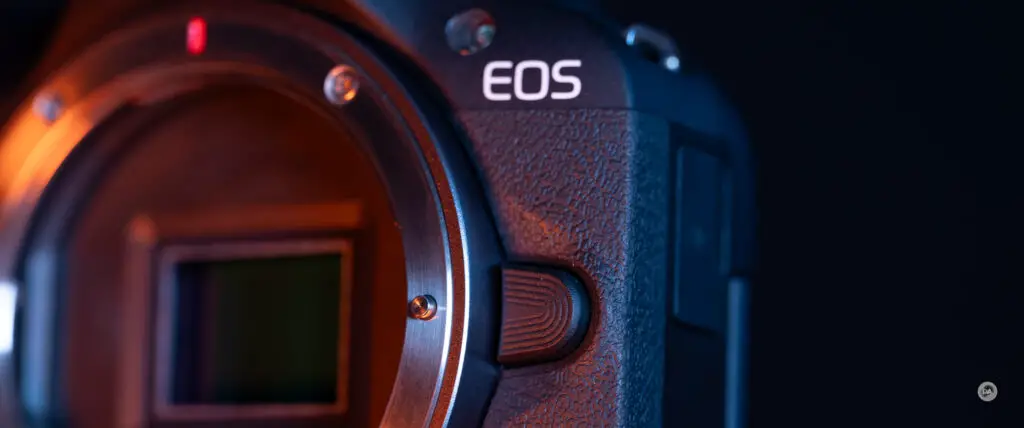
Canon’s initial mirrorless camera (the EOS M) arrived with a bit of a thud. It arrived at an MSRP of $799, and at that more premium pricing, the focus was more on the flaws than the strengths. So Canon dramatically slashed prices, and I bought in back in 2013 by getting a kit that included the EF-M 22mm F2, a little flash, and the camera…all for just $299 USD. That obviously made things much more attractive, and my review reflected that. I developed a lot of affection for the extremely compact EOS M (particularly with that equally compact 22mm F2 lens attached, and I got a lot of great pictures with it. I later upgraded to the EOS M3 in 2015 (my review here), and then reviewed the EOS M5 in 2017. When my daughter wanted a camera, we bought her the EOS M5. But my interest in the EOS M system waned because Canon just didn’t support it. In the essentially 10 years of the EOS M’s existence, Canon released a grand total of 8!!! lenses for it, with three of those lenses being variations of slow, boring kit lenses. Three prime lenses (only one being faster than F2), one macro lens, one wide angle zoom, and one telephoto zoom. The only thing that saved the platform was that it did have some third party support, with some Sigma and Viltrox autofocus prime lenses (3 each), a Tamron autofocus zoom, and then a large number of manual focus lenses from a variety of manufacturers. The EOS M cameras could also use any EF/EF-S lenses via adapter, which also helped, though using an adapter all of the time definitely gets old.

The last M body was released in 2020, and Canon has now officially discontinued the system and is all in on their RF mount instead, which unlike EF-M mount, started with full frame and has started trickling backwards into APS-C (starting in 2022) The Canon EOS R50 (being reviewed today), is the most recent budget RF-mount APS-C camera, coming to market with an MSRP $679 USD for the camera only or in kit with the RF-S 18-45mm F4.5-6.3 IS STM for $799 USD. Both of those prices are discounted by $100 at the time of this review. The transition from EF-M to RF brings both good and bad, and we’ll explore those realities in this review. If you prefer to watch your reviews, check out my video review here.
__________________________________________________________________________________________________
Follow Me @ YouTube | Patreon | Instagram | Facebook | DA Merchandise | Flickr | 500px | X
Thanks to Camera Canada for sending me a review loaner of this camera. They have become my go-to retailer for my own purchases here in Canada. As always, this is a completely independent review, and the thoughts and opinions expressed here are my own.
__________________________________________________________________________________________________
The strengths of the transition to the RF mount are obvious; essentially all of Canon’s development in in the RF mount space. We haven’t seen anything new in anything with “EF” in it’s name from Canon for a long time (EF, EF-S, or EF-M). There’s a much better chance of support for the EOS R50 because of the R in its name. Canon is nailing things like autofocus in their cameras, with amazingly robust and useful autofocus systems even in these budget cameras.
But the transition to R also comes with Canon’s current policies, which means that all third party autofocus development for the platform is currently forbidden. On EF-M we had Sigma, Tamron, and Viltrox lenses; we have none of those on RF. And thus far in the first two years of APS-C RF-mount cameras we have the same problem we encountered with EF-M: a complete lack of lens development. If I go to the Canon site in April 2024 and look at the RF-S lenses available, here’s what I get:

Four lenses. Two kit lenses, one slow telephoto zoom, and one slow wide angle zoom. Three of the four have a maximum aperture of F6.3 on the telephoto end, the other has a maximum aperture of F7.1 on the telephoto end! Forgive me if I have a hard time getting excited over that lens selection. I reviewed the RF-S 18-150mm back in 2022, but found that I actually liked the EF-M version better. The only lens there I find even remotely interesting is the wide angle zoom, as that tends to be something that Canon does reasonably well. This is a severe disadvantage for Canon to compete with Sony’s APS-C cameras, as while Sony has their own difficulties, there are probably nearly 100 autofocusing APS-C lenses available for Sony E-mount. I suspect the Canon EOS R50 will be a fairly popular camera based on its merits, but Canon absolutely has to be more serious about lens development for RF-S than they were with EF-M! At some point pointing to compatibility with ever older EF lenses via adapter simply isn’t going to cut it. I ended up mostly using full frame RF mount lenses during my review for the simple reason that I don’t particularly enjoy slow kit lenses.

Put simply, I’ve been more than a little frustrated by Canon’s approach to RF on a number of levels. But we will move on from that broader discussion to looks more specifically at the EOS R50, starting with a look at its basic specs.
Spec List
What’s Here:
- 24.2 Megapixel APS-C Canon CMOS Imaging Sensor
- DIGIC X Image Processor
- ISO 100-32000, Expandable up to 51200
- High-Speed Continuous Shooting at up to 12 fps with the 1st Curtain Electronic Shutter and 15 fps with the Electronic Shutter (no Full Mechanical Shutter available), up to 1/8000 shutter
- Excellent Dual Pixel CMOS AF system
- AF Working Range of EV -4 – 20
- 4K UHD 30 fps with no crop (6K oversampling, 10-bit), FHD 120 fps
- Coordinated IS (Optical IS and Digital Movie IS), Aspect Ratio Markers (matching social media sites)
- Focus Bracketing
- 0.39″ (9.9mm) OLED Color EVF, 2.36 million dots
- 3″ Vari-Angle LCD Touchscreen with 1.62 million dots
- Single UHS-I SD Memory Card Slot
- Digital 2x and 4x extender (JPEG support only)
- Multi-function hot shoe
- Built-in Wi-Fi and Bluetooth
- RF Lens Mount, Compatible with EF/EF-S/TS-E/MP-E Lenses with Adapter
What’s Missing:
- No IBIS (In-Body Image Stabilizer)
- No LCD coatings
- No self-cleaning imaging sensor
- No Headphone Port
- No Remote Port
- No highlight alert during playback
Build and Features
In many ways the EOS R50 reminds me more of Canon’s SL1 and SL2 mini-DSLRs ergonomically than any of the M cameras that I’ve used or reviewed. The most recent M camera that I used was the EOS M5, and it actually had a much more robust set of physical controls than the R50 (4 control dials). The R50 makes due to with just one control dial, with the mode dial sitting in the place that a second control dial would typically occupy. This is pretty hard to accept for someone like myself who is used to shooting with professional cameras and their more robust physical controls, and sends a pretty clear picture of who Canon is making this camera for.
Not me.
No, this camera is designed to capture the crowd who want better image quality than their camera phones can provide but who aren’t interested in a lot of technicality in the process. This is a camera designed more around those who want to put the camera in auto mode and use it like a point and shoot.
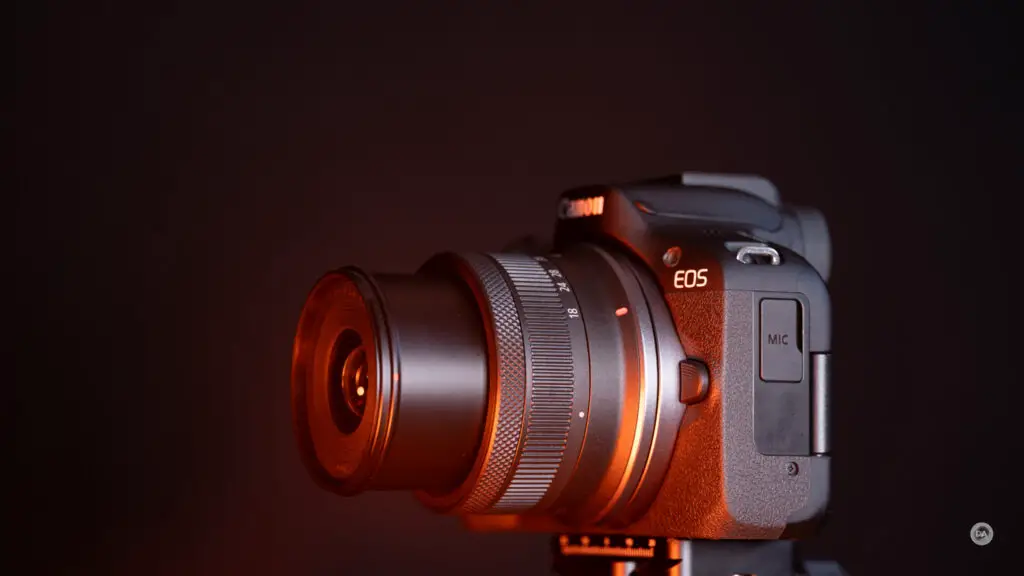
I just got finished doing my review of the Canon EOS R8, and while that is also a compact, budget model (though a more expensive full frame camera), I came away having loved the user experience of the R8. I enjoyed the handling despite a few minor limitations, and found that the camera fit my hand well despite its compact nature. That’s not true of the R50. It’s too small for my hands…but not small enough to fit everywhere in the way that the EOS M was. Now, to be fair, the EOS M had basically zero grip. It was pretty much a rectangle with a bit of grip surface on the right side. The EOS R50 has much more of a grip on it, but unfortunately the low height of the camera/grip makes it to small for my fingers to fit on it (pinky had no place to go) and the shallow depth of the grip makes it difficult for me to curl my fingers around it and feel like the grip was molding to my fingers. I feel more like I’m pinching the camera than gripping it.

I went to my wife for a second opinion. She has small hands, and so I had her grip and hold the EOS R50 and shoot with it a bit (I had the RF 28mm F2.8 attached as a nice, compact prime lens to fit the size of the camera). She found the small size and balance of the R50 an asset rather than a liability; it fit her hands better than my typical cameras.

The ergonomics of this body will largely depend on the size of your hands unless having a very small camera is a priority for you otherwise.
The EOS R50 is 4.6 [W] x 3.4 [H] x 2.7″ [D], or 132.59 x 86.11 x 70.1 mm, and weighs just 13.2 oz (375g) even with the battery and memory card installed.
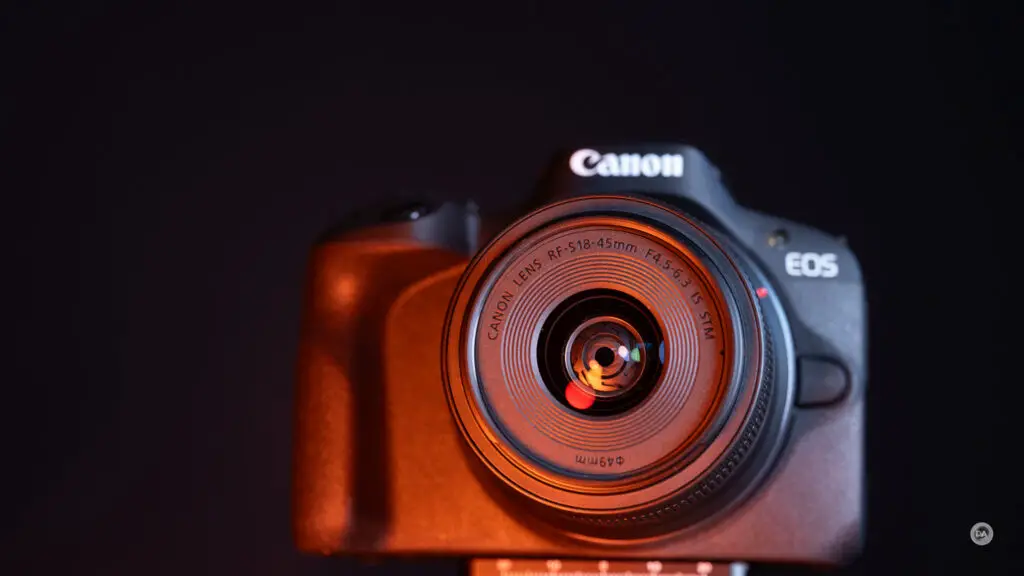
The primary controls come via the one control dial (on the top of the camera behind the shutter button) and the D-pad. Pressing up on the D-Pad will change the function of the control dial in certain modes (in AV mode it switches between aperture control and exposure compensation, while in Manual it switches between aperture control and shutter speed). An additional control point can be found via the control ring on all of Canon’s RF mount lenses in some form, though that implementation varies a bit from lens to lens (it might be shared as the focus ring on some lenses, for example). It’s clear that Canon was counting on people accustomed to using touchscreens being the ones to buy this camera, as the touchscreen will provide the most direct access to many controls.
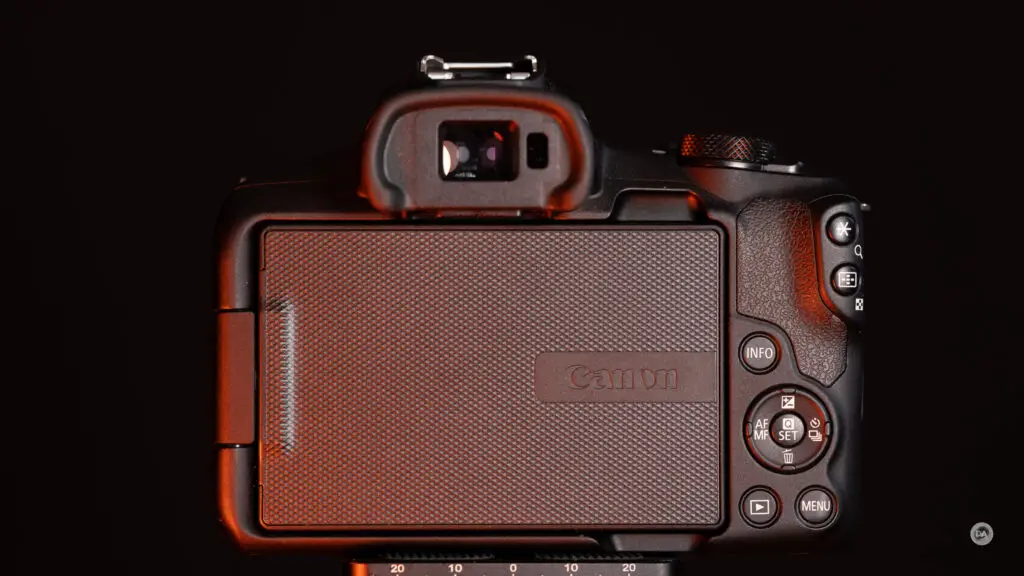
Fortunately Canon’s touchscreens are very good. The back of the camera is dominated by a comparatively large 3” articulating LCD touchscreen with a 1.62 million dot resolution. This is a very nice LCD for this class, and both the resolution and the responsiveness are very nice. Canon’s menu design is the friendliest of the brands I test to navigate by touch.

The first layer to the menus whenever you switch modes is to a simple visual representation of how the mode operates, reminding you that this camera is designed for people who might not be familiar with how cameras operate.
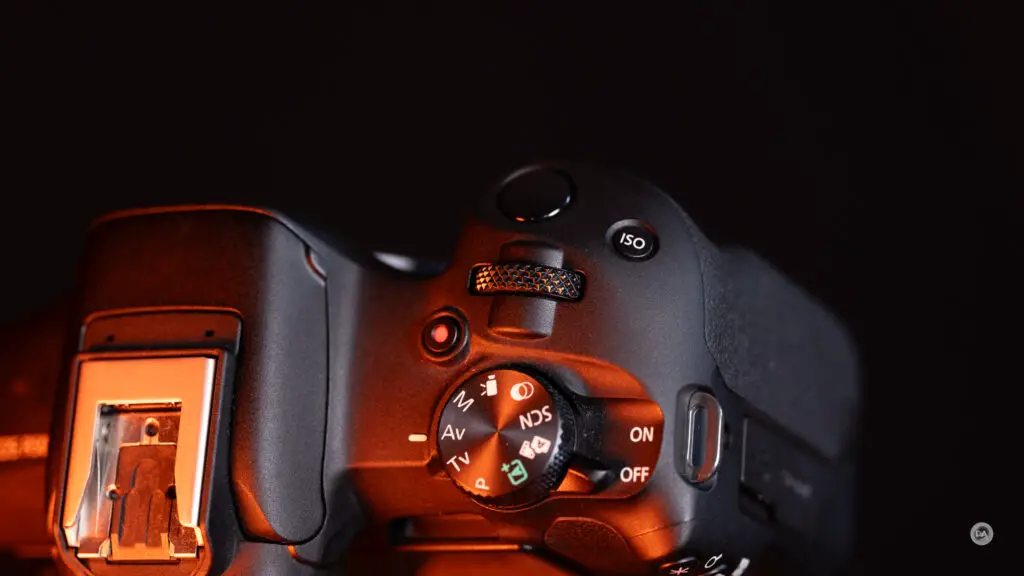
Unlike Canon’s higher end model, there is no main switch between video and stills setups. Video mode is just another mode on the main mode dial that sits on top of the camera. There are no custom modes on the top dial but rather an additional automatic mode that is nod towards the intended audience of the camera. There’s even a Hybrid Auto mode that captures a movie 2-4 seconds before the photo is taken, giving you something akin to Apple’s Live Photos on iPhones.
Also on top is a small video record button, a tiny, recessed ISO button, and then the shutter and the ON/OFF lever.

The front of the camera just has the lens release. There are no custom buttons there. Unlike their more expensive models, there is no option to have the shutter blades come down when the camera is powered off to protect the sensor from dust. There also isn’t auto cleaning for the sensor, so having a good blower might come in handy.
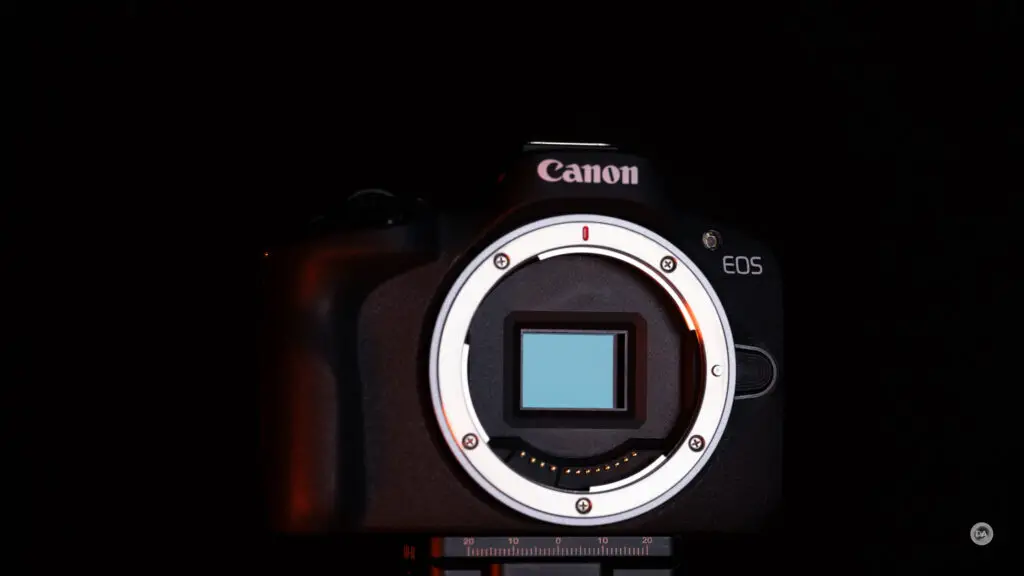
There is a Canon-standard set of buttons present on the back of the camera, most all of which can be customized to different functions. Everything is pretty much in the place I’ve come to expect on a compact Canon camera. These buttons are pretty small and quite flush, so expect them to be a little difficult to find and operate if you happen to be wearing gloves.
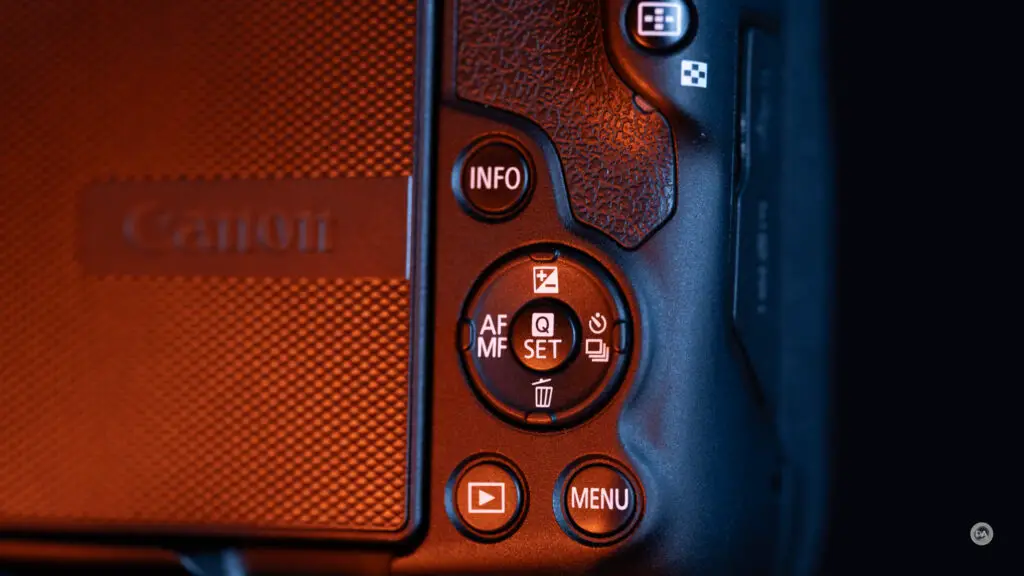
The viewfinder is an OLED electronic viewfinder with a 2.36 million dot resolution. It’s only 0.39″ in size, so not overly engaging, and has a magnification level of 0.96x. Pretty standard stuff.

The diopter for adjusting for your eyesight is underneath the viewfinder but is very difficult to adjust (it is quite flush and tends to make big rather than subtle adjustments).
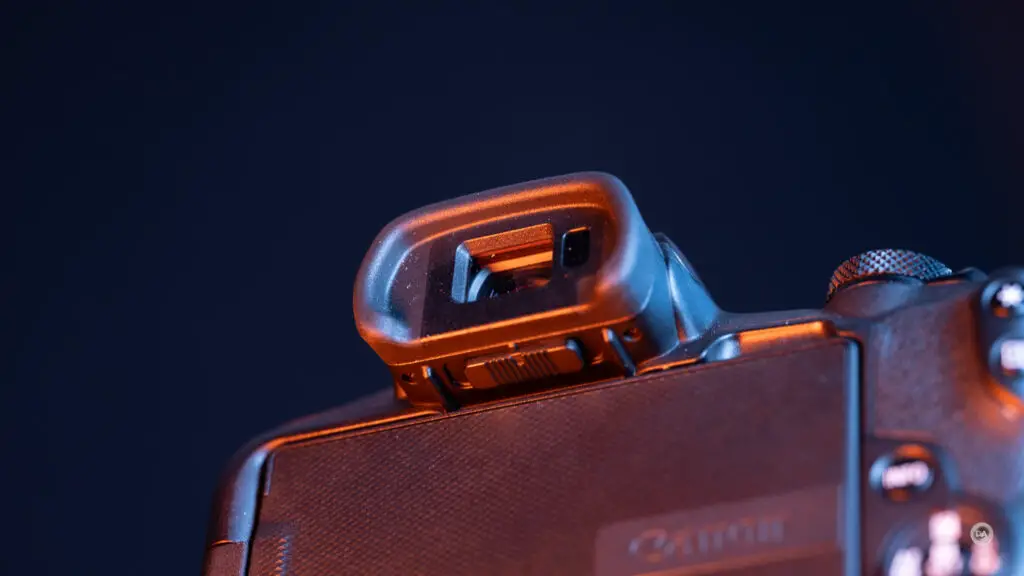
There is a small flash on top of the viewfinder stack, though I couldn’t find any kind of guide rating for it. I would avoid using the flash whenever possible, as an on-camera flash like this rarely produces flattering results.

The ports on the EOS R50 are divided between the left and right sides of the camera. These ports unfortunately continue the trend of having flaps (hard to keep out of the way) instead of doors that can be smoothly opened (and left open when desired). On the left side there is a single port for a 3.5mm microphone end to plugged into the jack.

On the right side of the camera rests a USB Type-C port for communication along with a micro-HDMI video out. That latter is a Canon standard and is rarely anyone’s favorite for the simple reason that micro-HDMI is more flimsy than larger HDMI ports. The micro-HDMI is a bit more justified here because of the extremely small nature of the camera. You can charge the camera via the USB-C port, though you’ll need a power bank with the appropriate power delivery (PD) standard. The hot-shoe on top allows you to connect certain microphones and get digital audio through it. The most obvious missing features here are a headphone monitoring jack along with a remote shutter release port.

The lone memory card slot is unfortunately in the undesirable position of being down in the battery compartment. We have a single SD/SDHC/SDXC slot that is unfortunately of the slower UHS-I variety (which definitely contributes to the very shallow buffer that we’ll discuss in a moment). The card position isn’t surprising, per se, but certainly not welcome, either. I hate this position, myself, as it leaves you with two unpalatable choices with the memory card out. One is put the camera on it’s side to leave the battery door open. The other is to close it so that you can put the camera down normally, but then you run the risk of forgetting that the memory card is not inserted back in the camera, which can be disastrous if you are arrive on site to shoot only to realize there is no card in the camera.
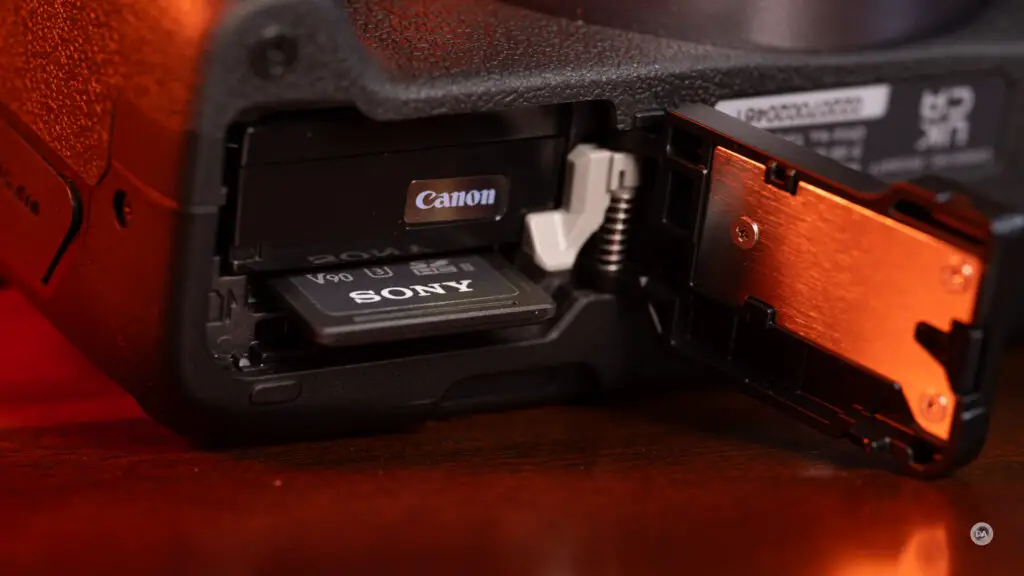
The battery is the LP-E17 battery pack that has a capacity of 1040mAh. This isn’t a particularly large battery, though the rating here is much better than what I saw for the same battery pack on the EOS R8. It is rated The rating is 440 shots when using the LCD screen, though that rating drops to 310 shots when using the viewfinder. I’ve always found it a little odd that the tiny viewfinder uses more power than the much larger LCD screen! As with most Canon battery packs, it isn’t hard to exceed the rating and get more shots per charge, though I would definitely recommend buying a spare or two…particularly if you plan on shooting 4K video, which can burn through a charge pretty quickly.
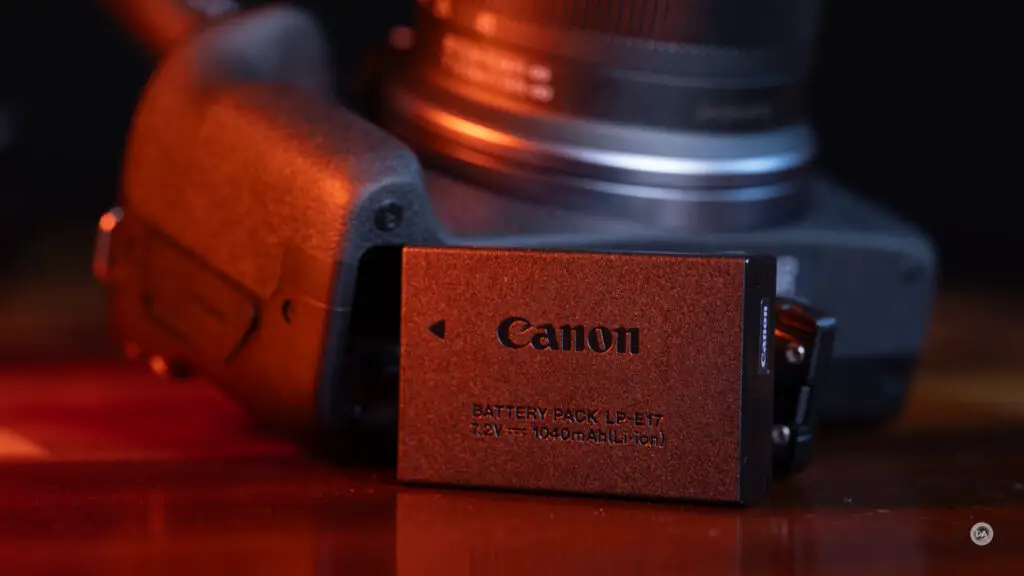
The shutter is interesting, as there isn’t a fully mechanical shutter option, but rather an electronic first curtain mechanical option along with a fully electronic shutter option. The former has a shutter speed limit of 1/4000th second (and a surprisingly robust 12FPS burst rate) while the latter gives an upper limit of 1/8000th of a second and unlocks a slightly faster burst rate of 15FPS. The electronic shutter will just make a very quiet electronic click without a typical shutter sound, though you can engage a fully silent option. The EOS R50 will not have the ultrafast readout of a camera designed purely around an electronic shutter (like the EOS R3, for example), so there are some penalties for using the electronic shutter here. You can’t use it with a flash (no sync is available), can’t engage anti-flicker mode, and sometimes fast moving action might be distorted a bit (rolling shutter). Canon also uses 12bit A/D conversion with the electronic shutter rather than 14bit with the EFC shutter, but you probably won’t notice the difference.
Bottom line – the EFC option is more flexible and produces slightly better image quality, but it is much slower and has maximum shutter speed of 1/4000th. It gives you a very decent 1/250th flash sync speed. The electronic option unlocks much faster burst rates and a higher shutter speed limit, but has other limitations. Choose appropriately to your situation.
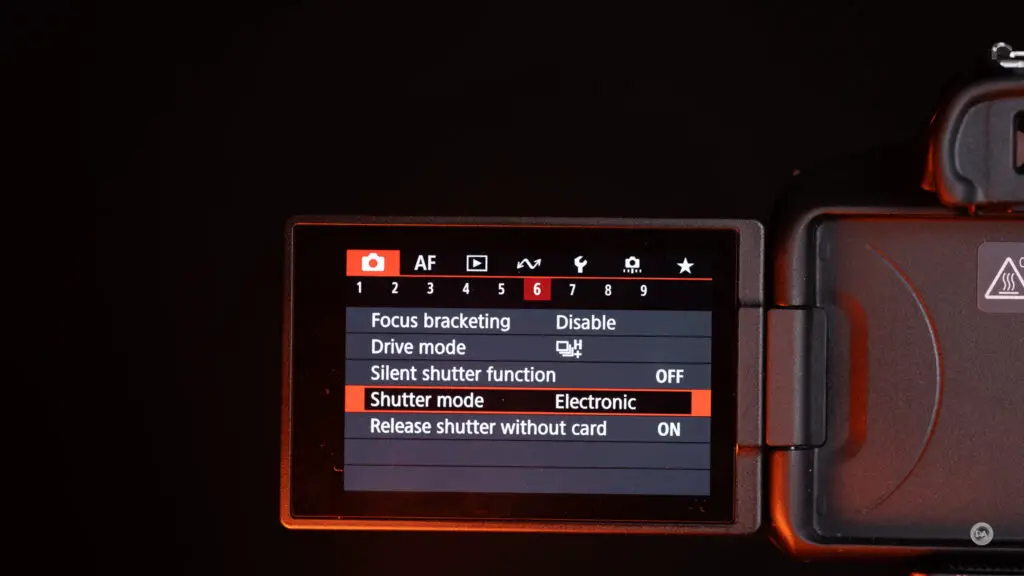
The EOS R50 does have some decent communication options including wireless LAN and Bluetooth 4.2.
The EOS R50 has bit of “plasticky” feeling to it, which is a bit surprising after the EOS M cameras that were largely made of magnesium alloy just like Canon’s bigger cameras. Again, I’m reminded more of the SL2 than the M5. You have the black option reviewed here, but also a white and grey version as well. There is no mention by Canon of any weather sealing in the body, so be careful in the rain.
Missing here is IBIS (in body image stabilization). That’s not unusual in a budget model like this, however. While there are a number of Canon lenses that do have lens based stabilization, about a third of them do not, and that number includes a number of the small, light primes that actually suit this camera (RF 16mm F2.8, 28mm F2.8, and 50mm F1.8).
There is a “Digital IS” available (for movie mode only), though this is a digital correction and will come at the cost of a crop of your video and won’t be as effective as an actual optical stabilizer.
The “kit lens” for the Canon EOS R50 is the Canon RF-S 18-45mm F4.5-6.3 IS STM and does have lens based stabilization, though the lens is not particularly good.
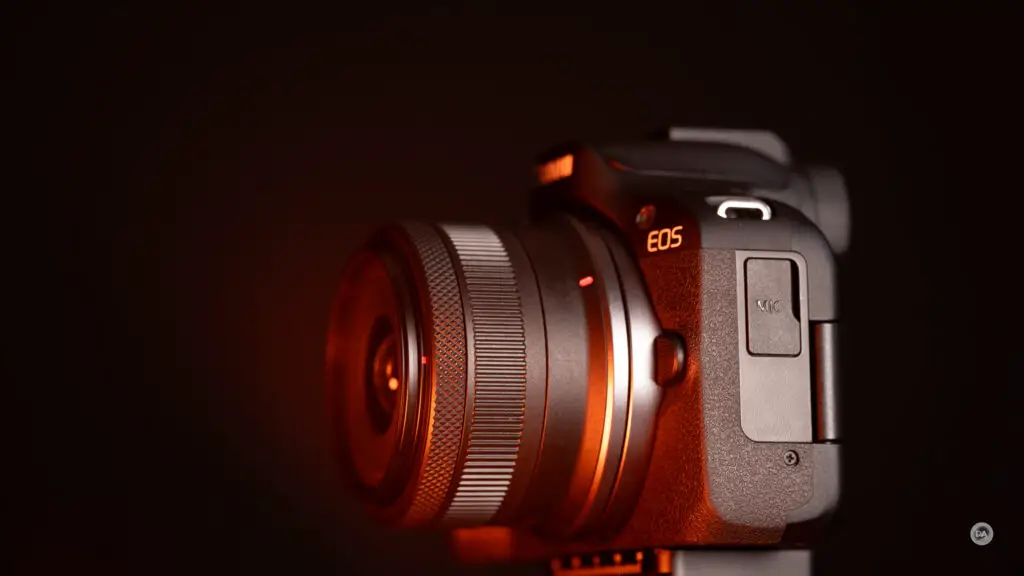
Every company makes a series of choices about what compromises to make in their lower-priced options. The EOS R50 has the typical mix of questionable omissions and surprising inclusions. If small is your goal, then the R50 is a winner. It’s downright tiny compared to the compact EOS R8:

Autofocus Performance
The place you’ll see the biggest upgrade over any EOS M camera is when it comes to the autofocus system. Canon has really nailed mirrorless autofocus over time, and the EOS R50 inherits that success. The EOS R50 utilizes Canon’s Dual Pixel CMOS AF focus system which covers approximately 100% x 100% of the picture area, with up to 651 automatically-selected AF zones utilized during Whole Area AF. Bottom line is that you can compose your shot basically anywhere with impunity, and the camera will also track all across the frame, making it easy to stop action even when your subject gets close to the camera.
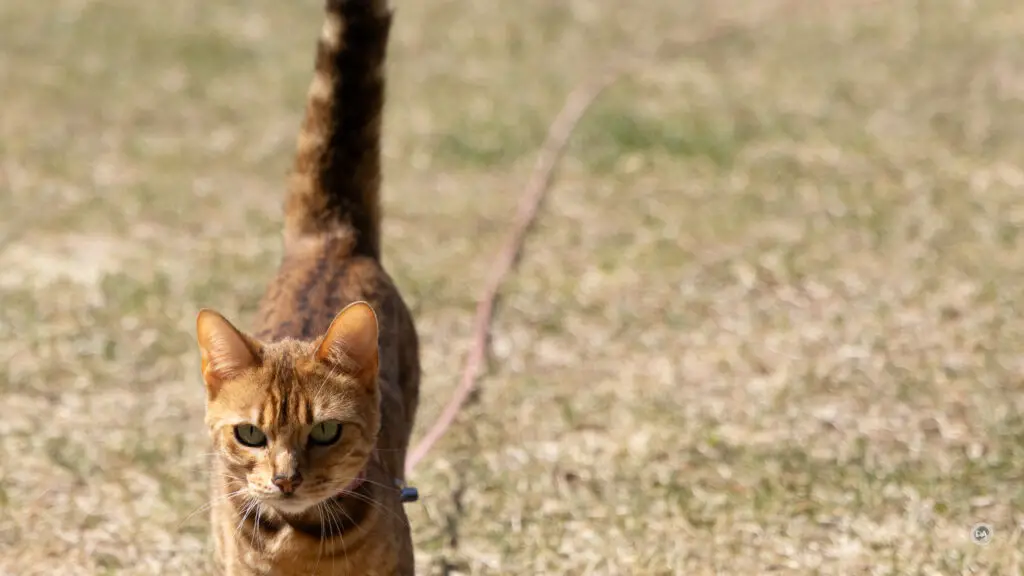
Available subject detection modes include People, Animals, and Vehicles, though Canon offers an “auto” mode for subject tracking that I really appreciate, as I have sometimes gotten less than excellent results on Sony or Fuji if I don’t have the right subject selected. I also really enjoy how engaging Canon’s tracking is. It is very clear on the screen what is being tracked.
Canon’s Whole Area AF works so well that you rarely need to resort to a more “precise” manual area control. On the rare occasion that the AF doesn’t grab what you want, simply touch the screen on the area you want to be in focus, and a smaller tracking box will lock over that.

It was very impressive to be using such a small camera and yet to have great subject tracking. I used the camera in an event setting and watched focus lock accurately onto the speaker every time and move with them as they moved around.

I used the R50 as a part of a portrait session where I used both the Samyang AF 85mm F1.4 (one of the early “forbidden” AF lenses released in Canon RF mount before Canon shut it down) alongside the Canon RF 28mm F2.8 STM. I got very good focus results from both lenses.
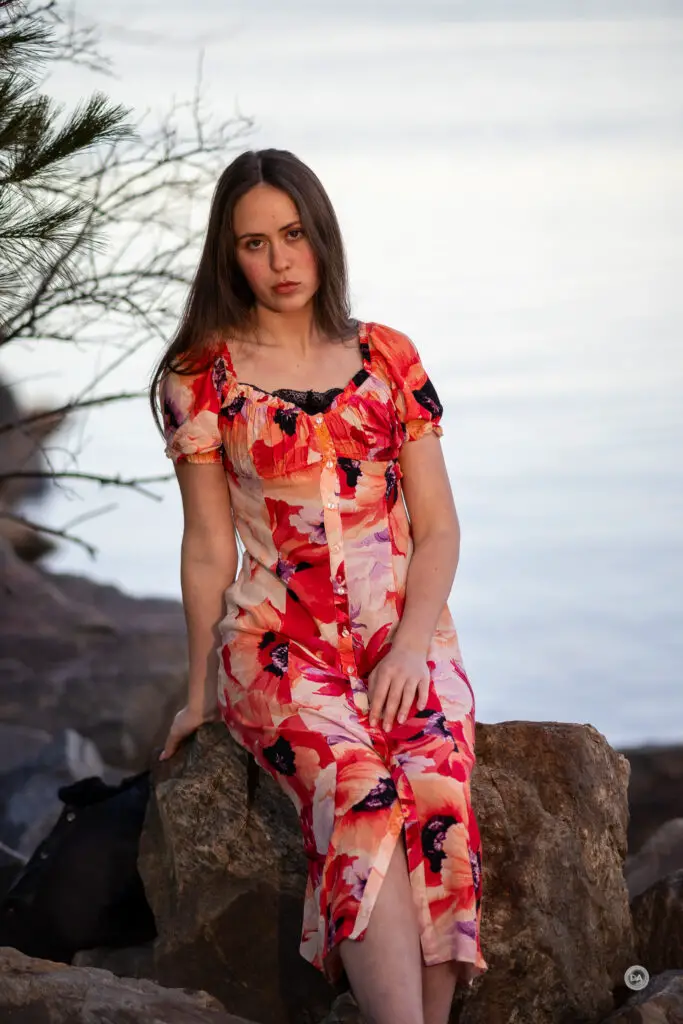
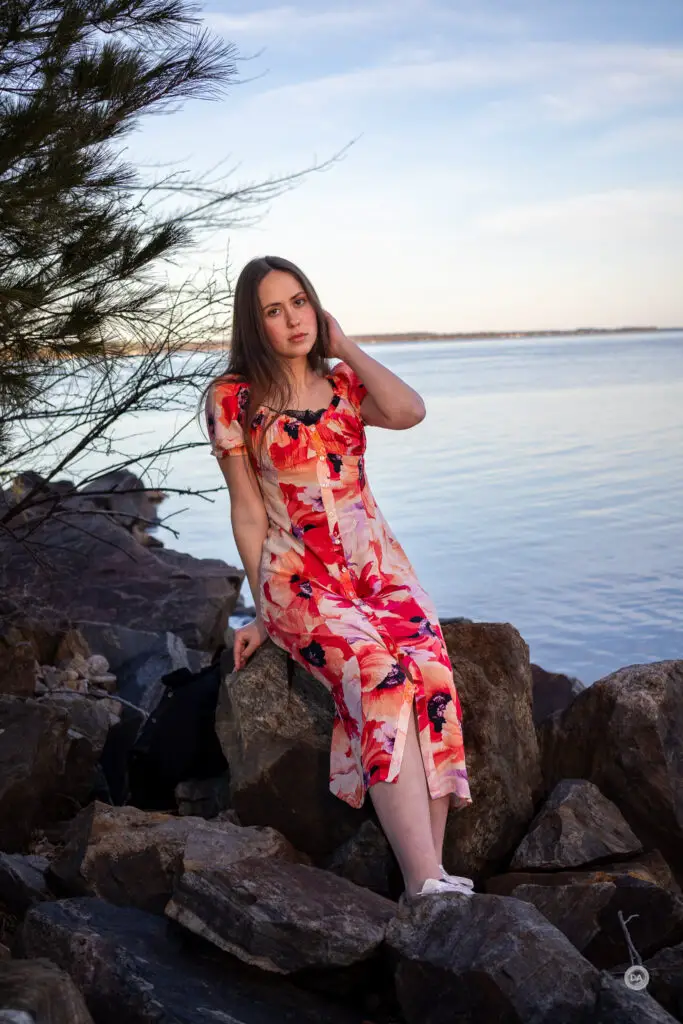

Focus sensitivity is fairly good, with focus system able to focus down to a -4 EV (which is quite dark), though that figure will vary depending on the maximum aperture available on the lens mounted. A lens with a very bright aperture (like the F1.2 lenses) gives the autofocus system the potential of much more light to work with than a lens with a dimmer aperture. Even with slower lenses, however, I was able to lock focus fairly quickly in very dim conditions.

Video mode uses the same basic AF system, though with slightly few AF zones (527 vs 651 for stills) and slightly less sensitivity (-3.5 vs -4). I also noted when doing some video work that Canon’s intelligent tracking works very well. If you click on a subject and select it you can easily move around the scene while keeping focus on the desired location.
The EOS R50 has very respectable burst rates of 12FPS with the EFCs and 15FPS with the electronic shutter, but those results are severely compromised by the slow UHS-1 card slot and low amount of RAM in the camera. Even with JPEGs you will see a maximum of 42 images at the slower burst rate and just 28 with the electronic shutter. The rating for RAW files with either shutter is…7 (half a second’s worth!), though that number will boost to 15 if you shoot the CRAW (compressed RAW) format. Ouch.

That shallow buffer is definitely going to be an issue if you want to capture action. You will encounter that frame limit almost immediately if you are shooting full RAW, and even with the very slightly higher buffer of CRAW, there’s a good chance that your buffer will fill before you capture the full action sequence (you’ll have less than one second). I found that I would get gaps in the action because the buffer would fill, the camera would pause, and then I’d get another burst of a few frames before it paused again.



I also didn’t find tracking as flawless as what I saw on the EOS R8 that I reviewed at the same time. I used the same Canon RF 24-105mm F4L IS on both lenses, and while every shot was nailed on the R8, I found that sometimes focus would shift to backfocus on the R50.
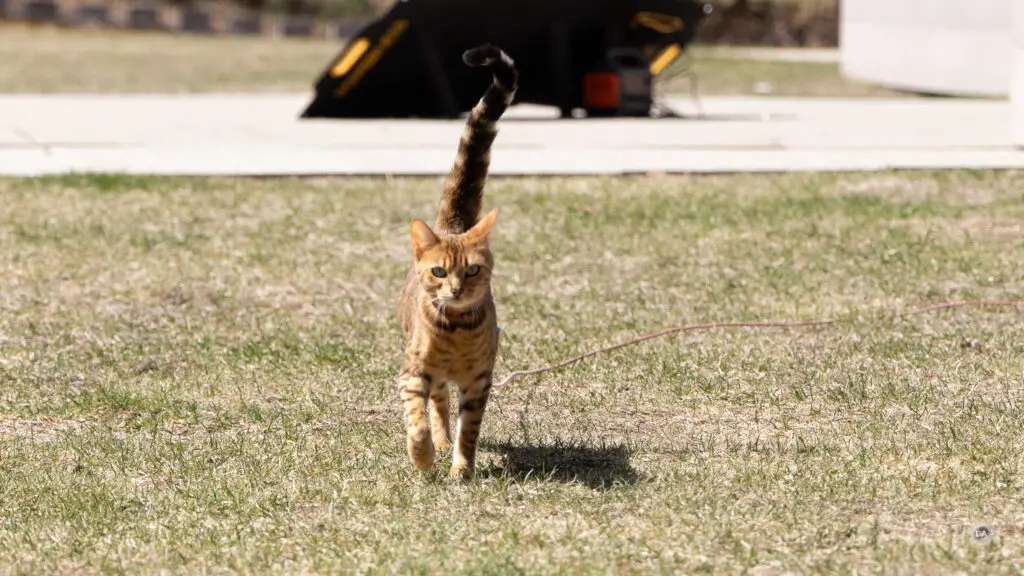
As long as you aren’t shooting too many bursts, this AF system is pretty fantastic for a little model like this. It’s a huge improvement over anything we ever saw on an EF-M camera. Getting well focused results in just about any setting is pretty much effortless. To get an AF system this good in a budget camera is, well, impressive.
Video Performance
The Canon EOS R50 doesn’t offer up many headline stats in the video department, but video recording capabilities are pretty solid. It can record 4K30 video with 6K oversampling. There is no crop factor, either – that is full sensor width. The main standout is that you have the option of shooting in HDR PQ to give higher dynamic range to the footage. Here’s a look at the various video formats available on the EOS R50 (from Canon’s “white paper” on the camera).

The maximum bitrate there is 120Mbps, and you’ll see that there aren’t really any recording limits outside of the constraints of your memory card, battery, or heating issues, though there is so little documentation given to the latter that I suspect it isn’t a major issue in this camera. Those recording times will shorten when shooting in HDR mode, however, as the bitrate for all of the formats increases.

As noted, 4K recording is limited to 30FPS, but up to 120FPS is available at Full HD (1080P) for slow-motion work. The EOS R50 does not get more advanced video features like LOG or the ability to output higher resolutions via HDMI.
The EOS R50 does have UVC/UAC compatibility which allows the camera to be used as a web camera to stream live video in Full HD without additional software. You have an option to shoot in vertical mode as well if so desired.
The vari-angle LCD is great for video, allowing you to shoot at waist height for more stability, down low on a gimbal, or front monitoring if you are in front of the camera.
I did see some obvious rolling shutter when panning with the camera while shooting movies, which does reduce the effectiveness of footage.
One final irk for me personally is that the main movie modes are restricted to full auto and/or full manual – no AV mode (my preferred format). There is a close up demo mode, but that is more about prioritizing focusing on close objects if you hold products towards the camera.
Sensor Performance
While I have reviewed other 24MP sensors from Canon, I haven’t reviewed this particular sensor before, as it was first used in the R10, a camera I haven’t reviewed. A quick look at Photons to Photos shows that in their tests this sensor does behave pretty identically to that found in the R10, and a little better than the older 24MP sensors found in cameras like the EOS M50 MK II. We’ll explore the highs and lows in this review, but, as expected, this is a camera capable of producing great results despite its compact size.

File options include RAW, CRAW, JPEG, and HEIF formats. Here’s a breakdown of the various aspect ratios and dimensions available along with the average file size for each.
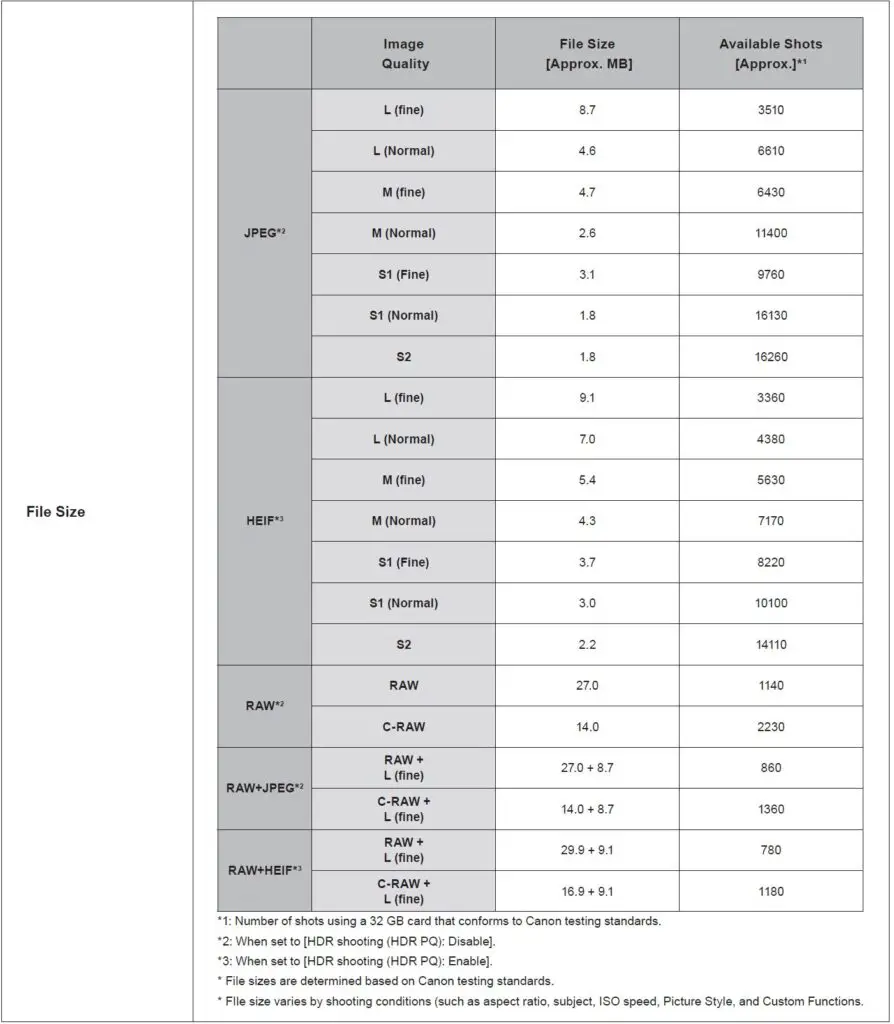
Canon used to offer Medium and Small RAW options but in more recent years has elected utilize their extremely efficient CRAW (Compressed RAW) option, which is a lossless compressed file that delivers both great efficiency in terms of file size but also very high quality. It is my go-to option in my cameras, as a lot of tests over the years have demonstrated that it is near impossible to spot any differences from the full size uncompressed RAW options. So, while offering near equal quality, CRAW delivers files that are only about 54% of the size of the uncompressed RAW options. At ISO 100, for example, an uncompressed RAW file will be around 27MB, while the CRAW file is a relatively diminutive 14MP. Canon .CR3 “wrapper” is extremely efficient as well, delivering smaller file sizes in general relative to competitor’s RAW files. The EOS R50’s images generally look great – good detail and color.

I was able to get nice looking images (like the one above) even with the kit lens (18-45mm) even if I didn’t love shooting with it.

In my tests I found some expected things…and some unexpected ones.
Dynamic Range
I’ve taken to referring to the charts over at Photons to Photos as a quick reference to supplement my own tests. According to them, the dynamic range performance of the EOS R50 is essentially identical to that of the EOS R10 (which stands to reason, as this is the same basic sensor), and this sensor is slightly better than other Canon APS-C sensors in dynamic range. They rate the R50 at a maximum of 10.57 stops of dynamic range, which is slightly better than the recent EOS R7’s sensor (10.49 stops) but significantly better than the 24MP sensor in the EOS M6 MK II (10.08 stops), which was tops among the EOS M cameras. This is as good as you’re going to get out of a Canon sensor right now for dynamic range, though both Fuji and Sony are capable of slightly better results…particularly if you move beyond base ISO.
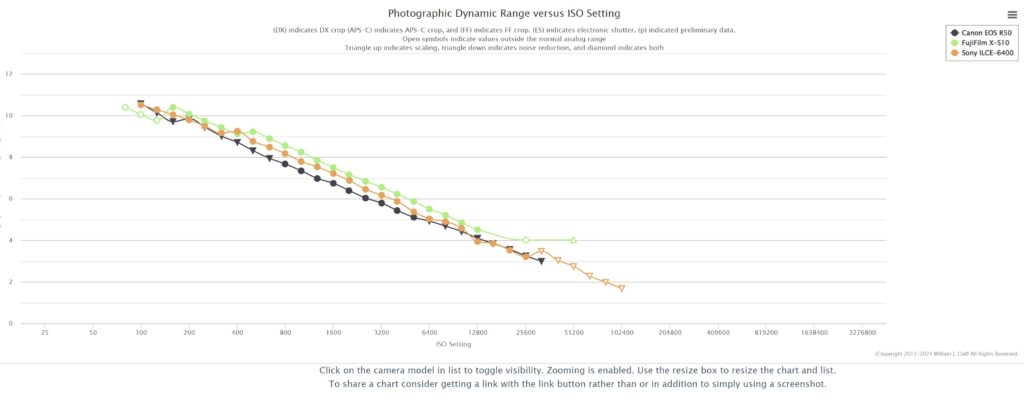
Bottom line is that this new Canon sensor is, by the numbers, a very competitive sensor for dynamic range performance. We’ll see how that bears out in real world testing.
For my tests, I establish a base exposure (neutral or correct) and then subsequently under and overexpose the image by progressive stops. I typically go as high as 4 stops of overexposure and 5 stops of underexposure as modern cameras tend to be better at recovering shadows than they do highlights. I then add or remove the appropriate stops of light in post to see how the sensor does in recovering the lost information. Here’s a look at the properly exposed image for reference:
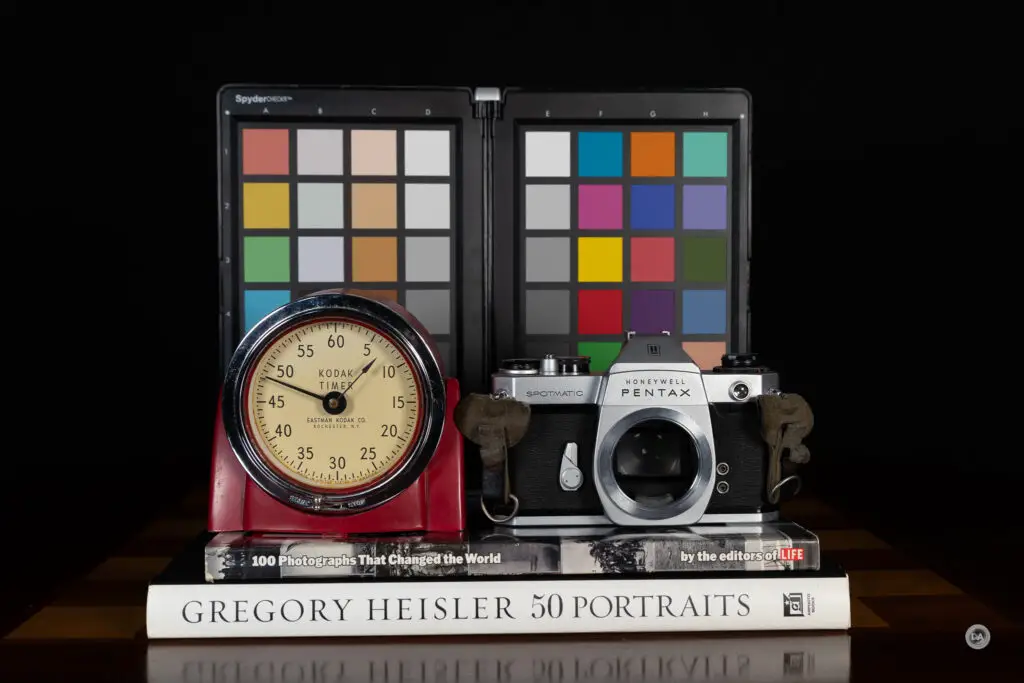
We will examine how the colors are retained, the purity of the shadows and highlights, and how noise impacts the image.
Modern cameras are typically very good at recovering shadows. At four stops of underexposure the unrecovered photo shows deeply crushed shadows and very little of the subject visible, but the shadows are easily and cleanly recovered by adding those four stops of light back into the photo. The end result is a photo that looks largely like the original (correct) exposure…at least on a global level.
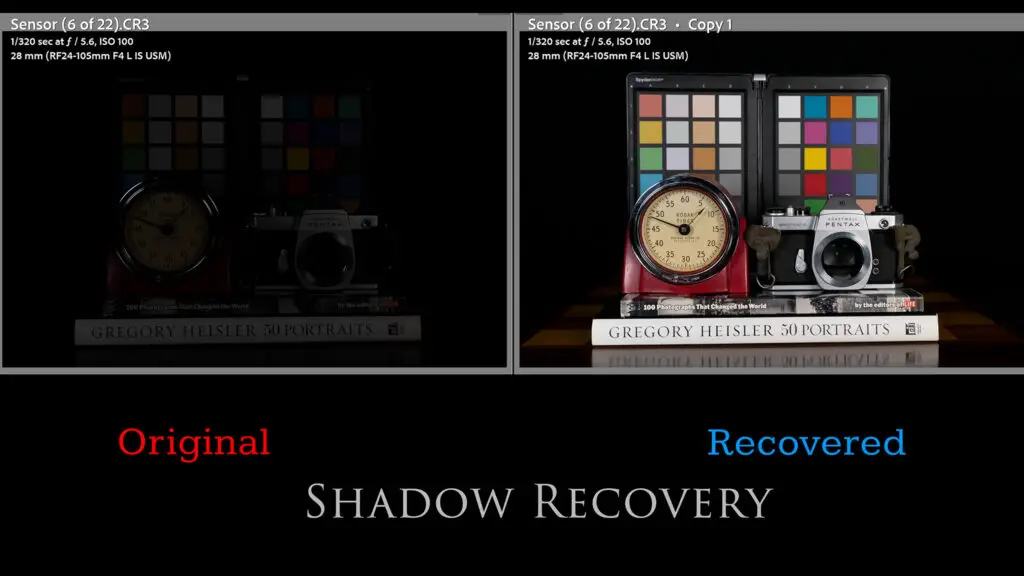
If we zoom in to a pixel level we can see that the shadows have a fair bit of noise and are more of a brown than black as a result.
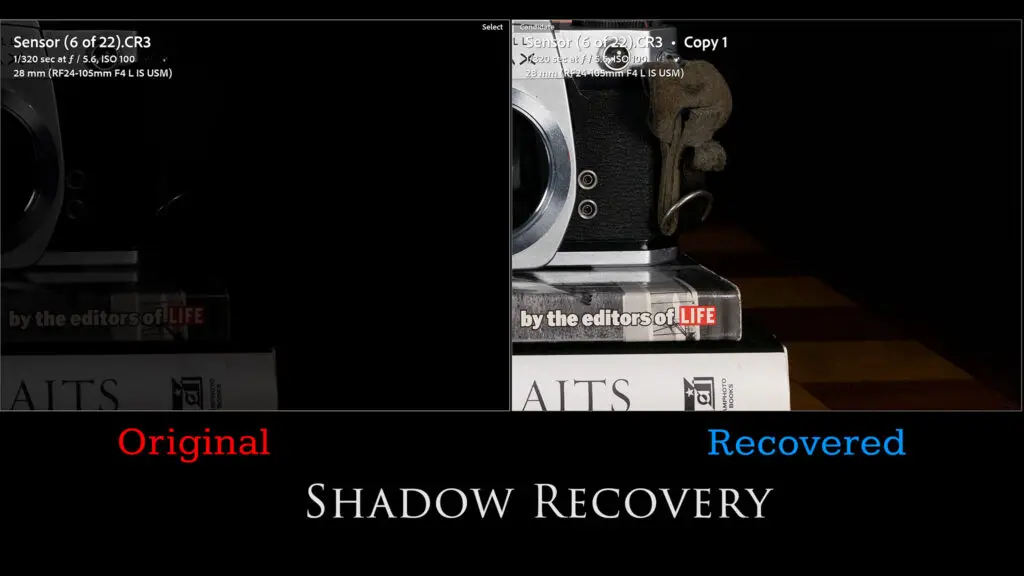
Things look quite a bit rougher at 5 stops, with some green and magenta color blotches showing up in black areas, and more obvious/rough noise.
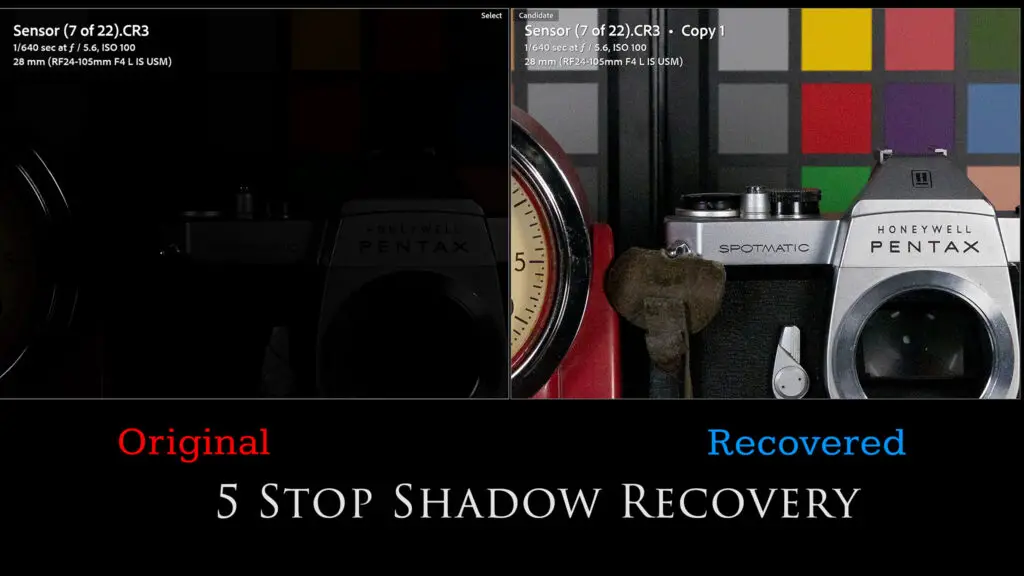
So, shadow recovery is good, but there is a limit to how far you can go without penalty. The sensor falls off more than competing sensors at higher ISO values, so here at ISO 400 (not very high!) I was surprised by how much noise I got when recovering the shadows on this image. It doesn’t look bad globally:

…but it is pretty noise at a pixel level:

How about highlights? We will now reverse the process. I’ve gradually overexposed a series of images, one stop at a time, and then attempted to recover the highlights in post. Typically you will start to see the image fall apart after a few stops in a couple of ways: 1) certain colors are lost and are not recoverable, and 2) information will be lost in blown highlights that isn’t recoverable.
At two stops the recovery (on the right) is near perfect. The color swatches all look correct and I don’t see lost information in the highlights. The color in the timer face on the left has been thoroughly recovered and looks even.
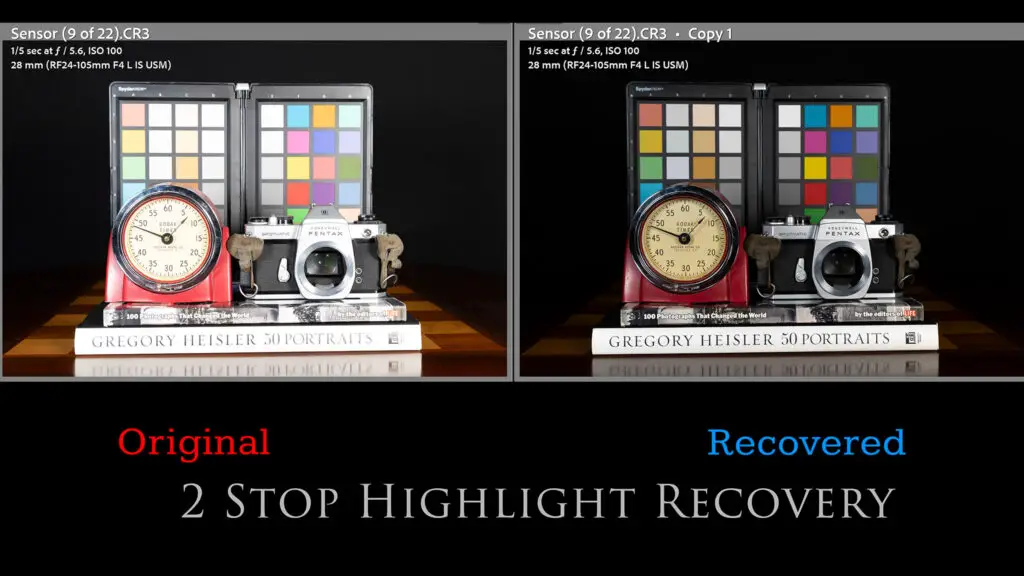
At three stops, however, the limits are slightly exceeded. You can see that in comparison to the 2 stop recovery (on the left) that the 3 stop recovery (on the right) on the right has missing color information on the timer face and some of the color swatches. Some of the texture is gone from the front of the Pentax camera.

The image is useless at four stops of overexposure, so don’t attempt that.
I found that there was sufficient real world dynamic range to allow me to recover both shadows and highlights enough to make real world results more pleasing, but I did see a bit more noise in the shadows than what I would prefer.
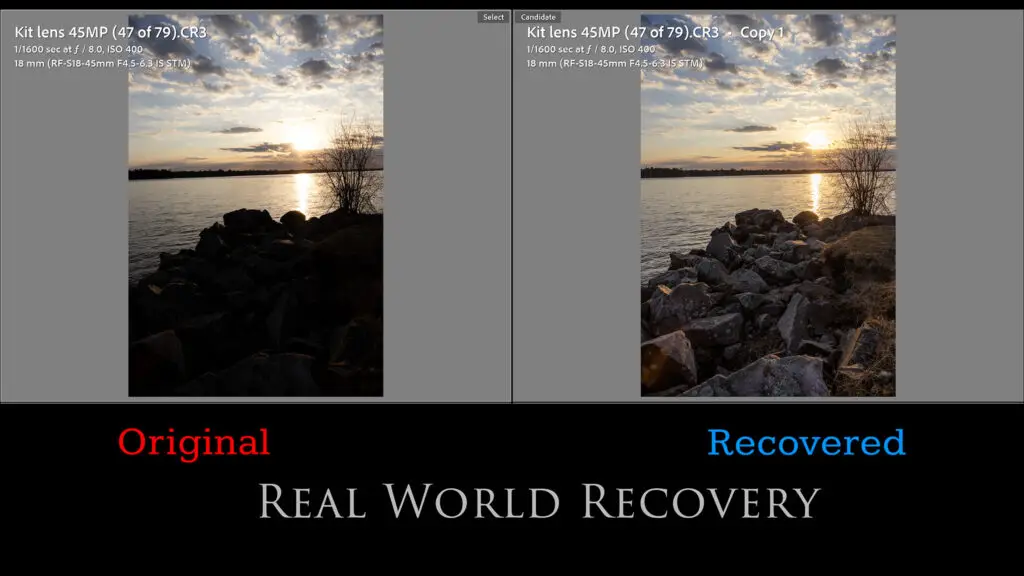
ISO Performance
In a perfect world we could all shoot in perfectly lit scenes, but reality dictates that sometimes we have to shoot in lower light situations. Raising the ISO always comes with some penalty, and surprisingly, the EOS R50 is a little worse in this regard than older Canon cameras with even higher resolution like the M6 MK II or the EOS R7.
I compared each stop of ISO in the standard range to the base ISO of 100. I was surprised to see a bit of increased noise even by ISO 1600.
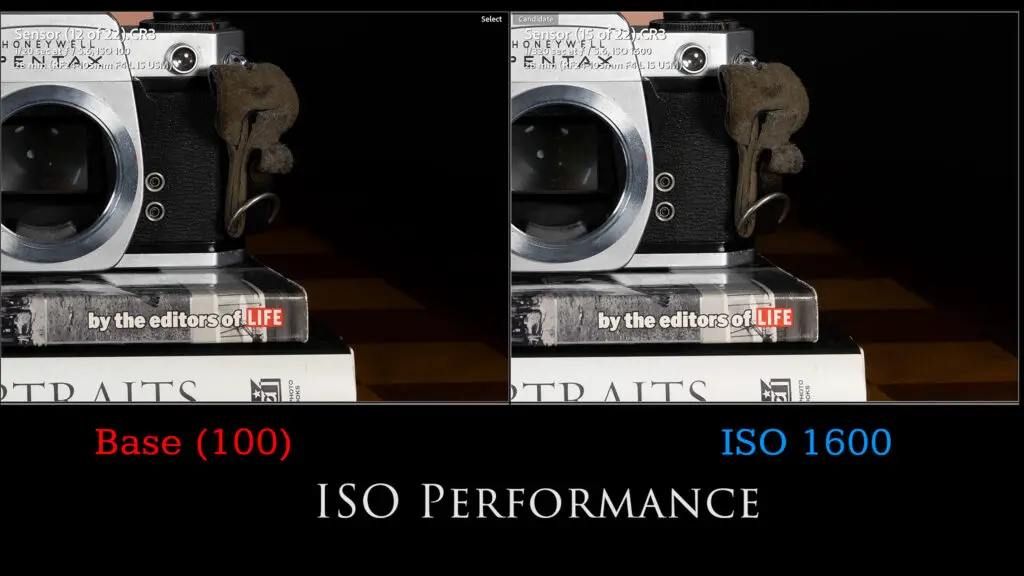
Things are a bit rougher at 3200, and rougher still at 6400, where I’m starting to see a bit of banding.
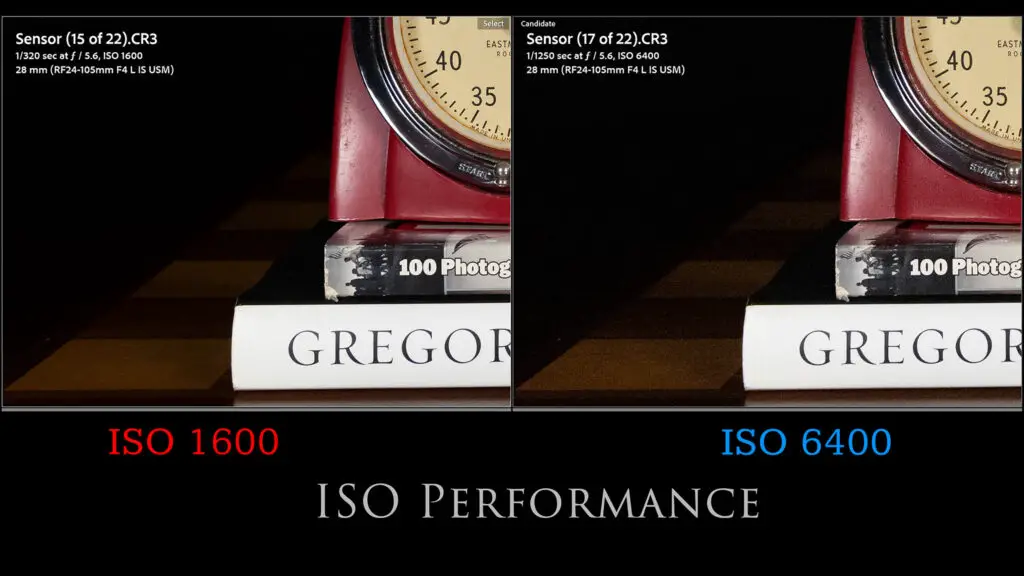
Everything gets rougher still by ISO 12,800, and I started to see some rings forming in the shadow area. This becomes very obvious by ISO 25,600 along with a green color shift and some very rough noise.
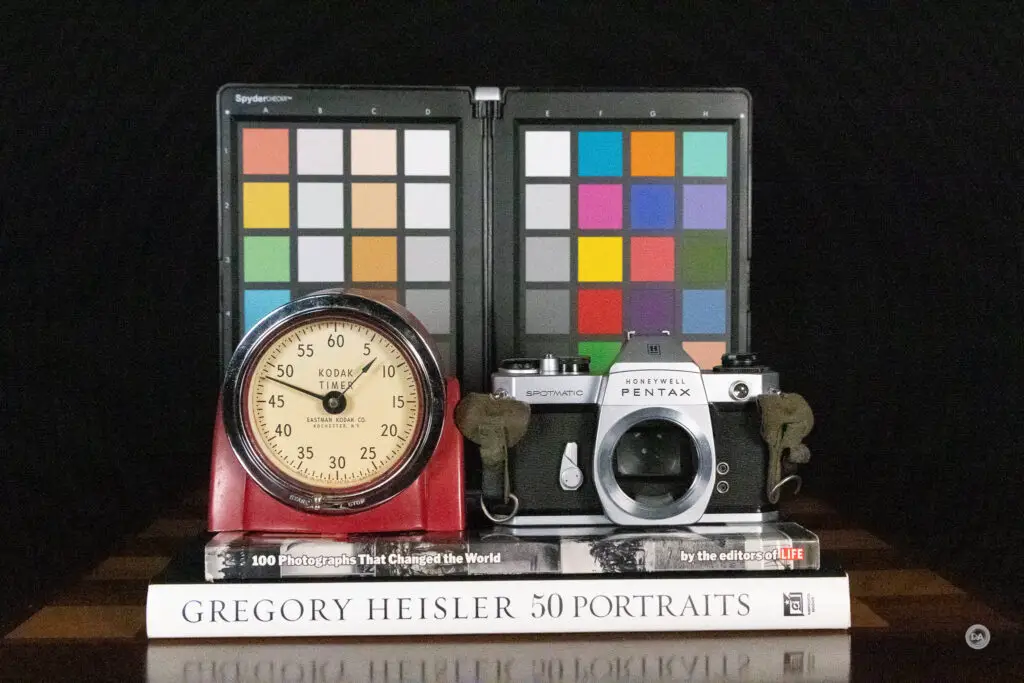
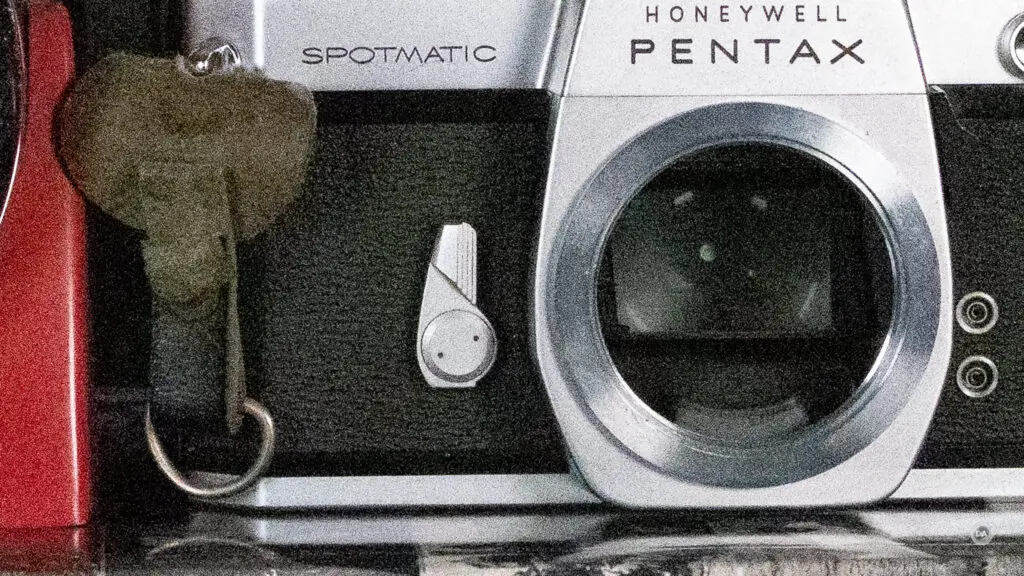
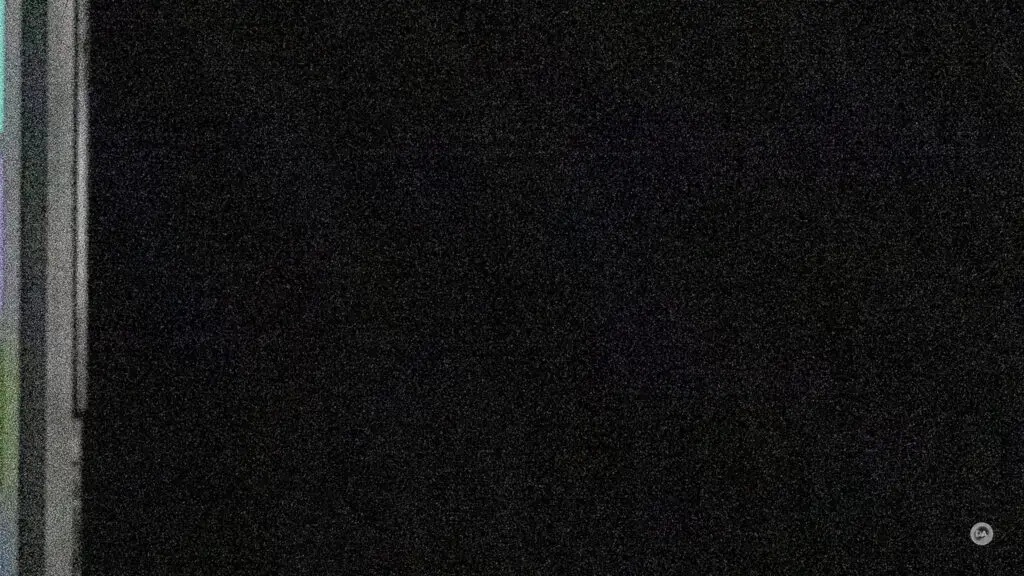
The native ISO range extends up 32,000, but I wouldn’t bother with anything past ISO 12,800 unless you plan to convert to monochrome.
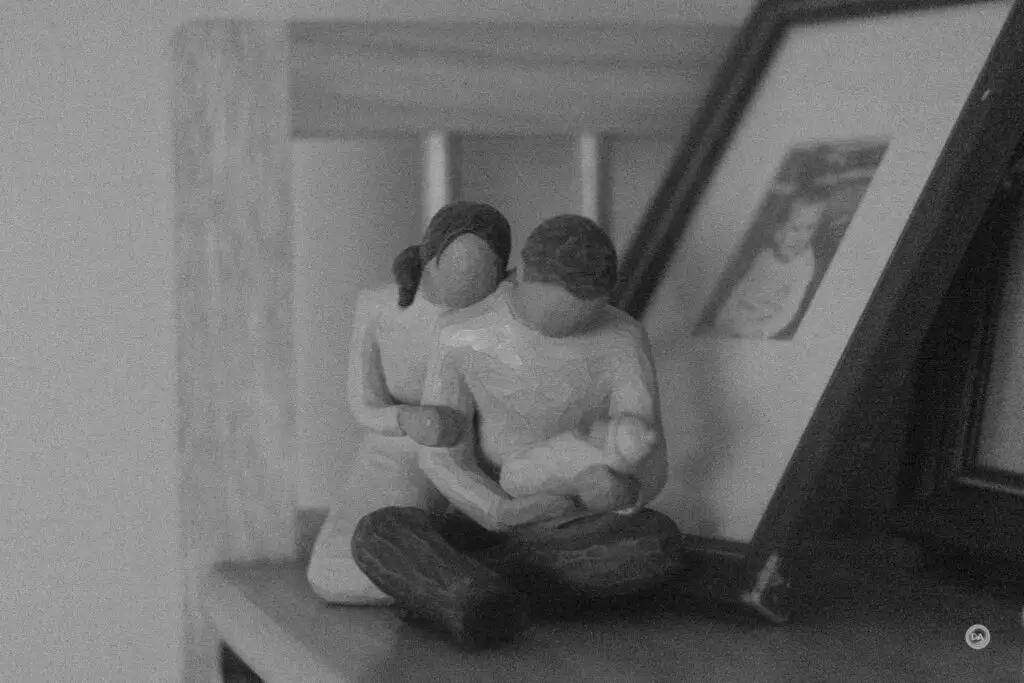
I shot the image above at ISO 25,600, and while the noise pattern is pretty rough, you don’t have to worry about color disfiguration and the lack of deep shadows kept the rings from showing up.
I saw much, much better results from the full frame EOS R8. I took the same shot at ISO 51,200 on the R8, and it looks much, much cleaner by comparison.
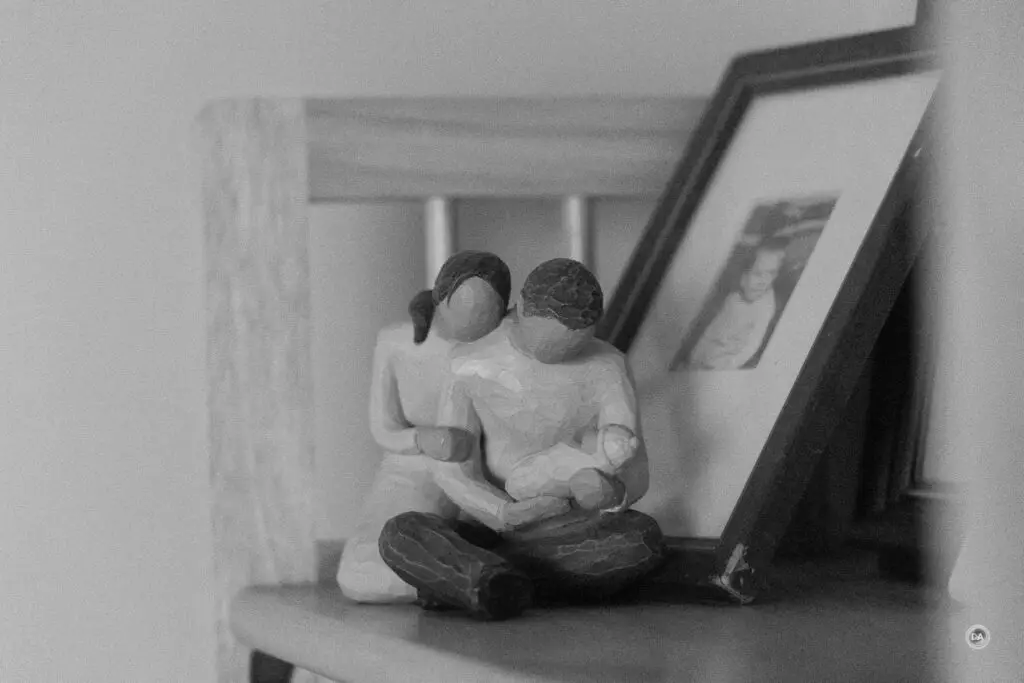
So far Canon has only produced slow maximum aperture zooms for the RF-S mount, and this shows the vulnerability of this approach. You have to increase the ISO more often with slow lenses, and unfortunately that takes more of a hit than what I would like on the R50.
Image Quality Summary
While I was reasonably happy with the sensor performance here, the fact of the matter is that both Sony and Fujifilm have had better APS-C sensors than this for years. Canon always get good marks for color performance, which certainly helps, even when using the cheap kit lens.
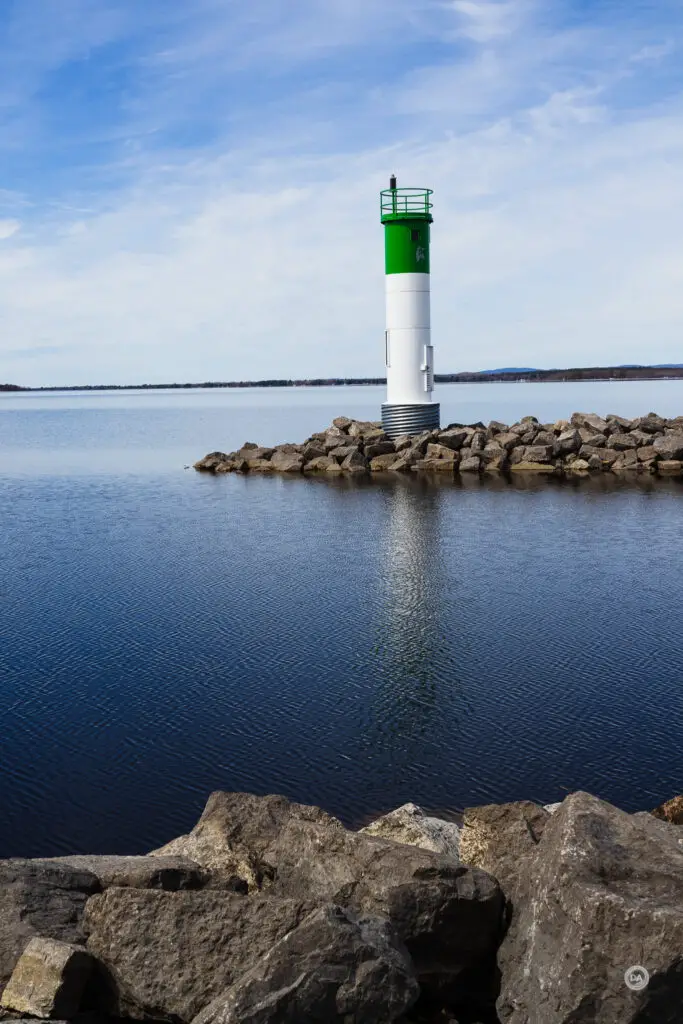
I also felt that skin tones were nicely reproduced, as per usual.

Unfortunately I don’t feel like the sensor has taken quite the leap ahead that the autofocus system has.
Conclusion
At $680 USD (currently $580 USD) the Canon EOS R50 will almost certainly sell well for Canon because it offers a reasonable amount of quality features for the very low price point. The only cheaper APS-C mirrorless camera is the Canon R100, and that camera comes without the articulating LCD screen and has an older focus system.
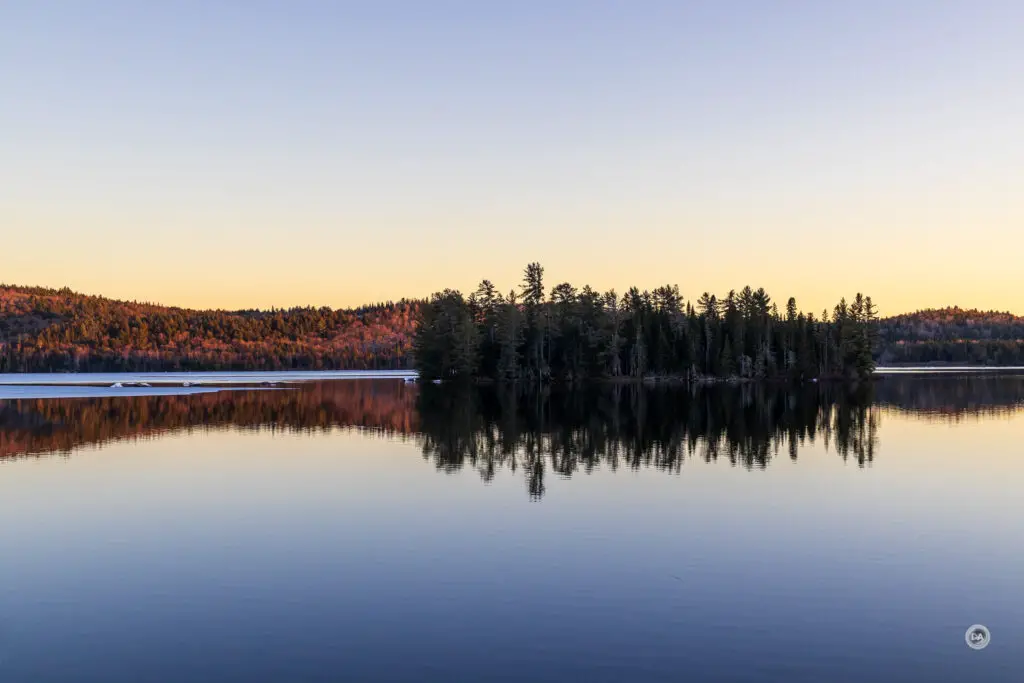
You’ll want to either have relatively small hands or else a strong desire for a compact camera, but, if that’s the case, you’ll enjoy having a decent viewfinder and an excellent touchscreen in such a compact camera. The autofocus system is very robust for this class of camera, which definitely ups the fun factor.

The biggest reason to hesitate on purchasing the Canon EOS R50 is the utter lack of native lenses available for it. Canon needs to demonstrate that they are going to support the RF-S mount in a way far better than their failure to support the EF-M mount. The current state of the EOS R system is that I really like and enjoying using many of the cameras, but I’m frustrated by the policies regarding lenses. There are very few mid-level lenses that offer great performance and features but without the premium pricing of Canon’s L series lenses. Unfortunately those are usually the lenses mostly produced by third party brands…and so far they are verboten. Here’s hoping that policy changes, as that will give cameras like the inexpensive EOS R50 a chance to shine.
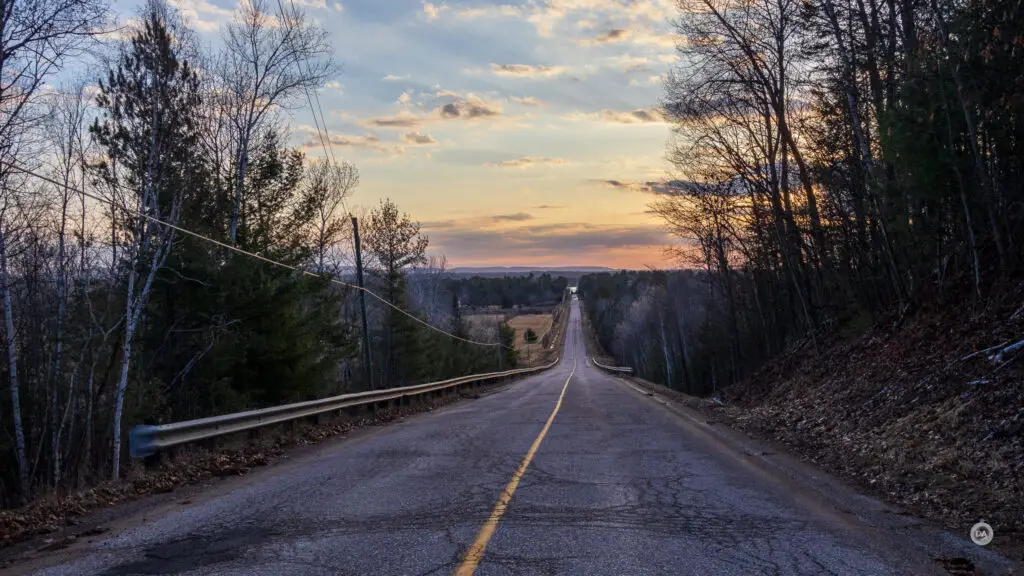
Pros:
- One of the cheapest APS-C mirrorless cameras on the market
- Responsive touchscreen with good resolution
- Better viewfinder position than Sony APS-C models
- Very useful burst rate with either EFC or Electronic shutters
- Autofocus system is the best out there at this price point
- Tracking is impressively good for a budget camera
- Love the “auto” mode for subject detection
- Good dynamic range
- Good color science
- Great price
- Decent video specs
- Oversampled 6K for 4K30 footage – looks great
Cons:
- Very few RF-S lenses available
- No AV mode in video
- More penalty at high ISO than expected
- Canon’s third party lens policy
_________________________________________________________________________
GEAR USED:
Purchase the Canon EOS R50 @ Camera Canada | B&H Photo | Adorama | Amazon | Amazon Canada | Amazon UK | Amazon Germany
___________________________________________________________________
Some Lenses to Consider:
Purchase a Canon RF-S 18-150mm @ B&H Photo | Amazon | Camera Canada | Amazon Canada | Amazon UK | Amazon Germany | Ebay
Purchase the Canon RF 28mm F2.8 @ Camera Canada | B&H Photo | Adorama | Amazon | Amazon Canada | Amazon UK | Amazon Germany
Purchase a Canon RF 16mm F2.8 STM @ B&H Photo | Amazon | Camera Canada | Amazon Canada | Amazon UK | Amazon Germany | eBay
Purchase the Canon RF 24mm F1.8 Macro IS @ B&H Photo | Amazon | Camera Canada | Amazon Canada | Amazon UK | Amazon Germany
Purchase the Canon RF 35mm F1.8 IS STM @ B&H | Amazon | Camera Canada Amazon Canada | Amazon UK | Amazon Germany | Ebay
Purchase a Canon RF 50mm F1.8 STM @ B&H Photo | Camera Canada | Amazon | Amazon Canada | Amazon UK | Amazon Germany | Ebay
Purchase a Canon RF 85mm F2 Macro IS STM @ B&H Photo | Camera Canada | Amazon | Amazon Canada | Amazon UK | Amazon Germany | Ebay
_________________________________________________________________
Want to support this channel? Use these affiliate links to shop at: B&H Photo | Amazon | Adorama | Camera Canada | Amazon Canada | Amazon UK | Ebay | Make a donation via Paypal
Buy DA Merchandise https://bit.ly/TWIMerch
Keywords: Canon EOS R50, EOS, R, R50, Review, M50, APS-C, RF, mirrorless, Sports, Tracking, Dustin Abbott, Real World, Comparison, Handling, Focus, Portraits, Resolution, High ISO, Image Quality, Sample Images, Photography, 45MP, 24MP, Canon, #letthelightin, #DA, #EOSR50
DISCLAIMER: This article and description contains affiliate links, which means that if you click on one of the product links, I’ll receive a small commission. As an Amazon Associate I earn from qualifying purchases.










 GOOVIS ART Head Mounted Display Review
GOOVIS ART Head Mounted Display Review 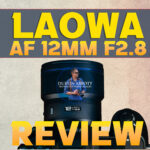 Laowa AF 12mm F2.8 Zero D Review (Z-Mount)
Laowa AF 12mm F2.8 Zero D Review (Z-Mount)  Nikkor Z 35mm F1.2 S Review
Nikkor Z 35mm F1.2 S Review  Kase AF 85mm F1.4 Review
Kase AF 85mm F1.4 Review 


